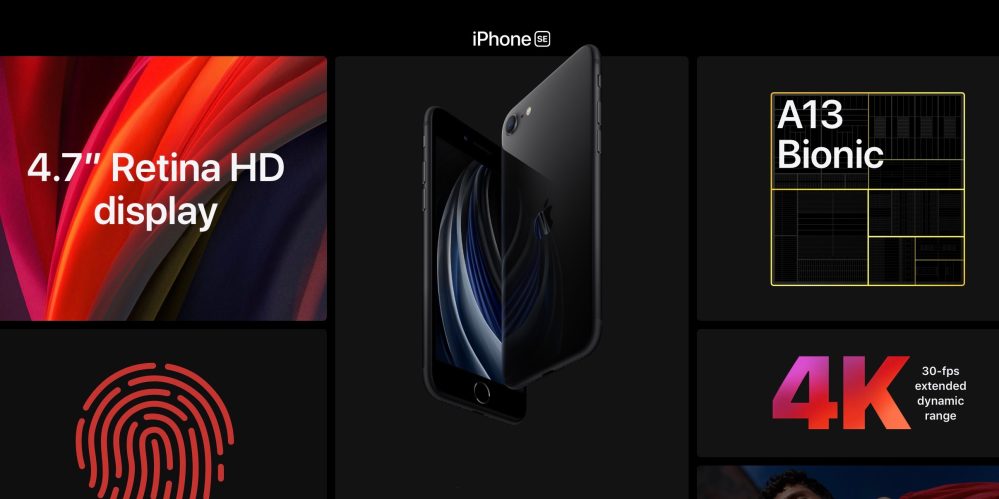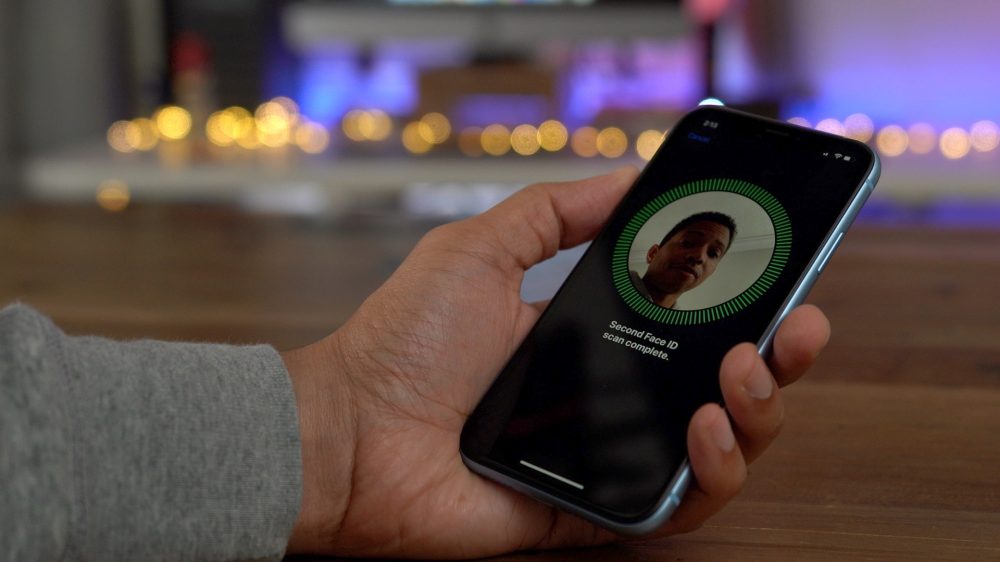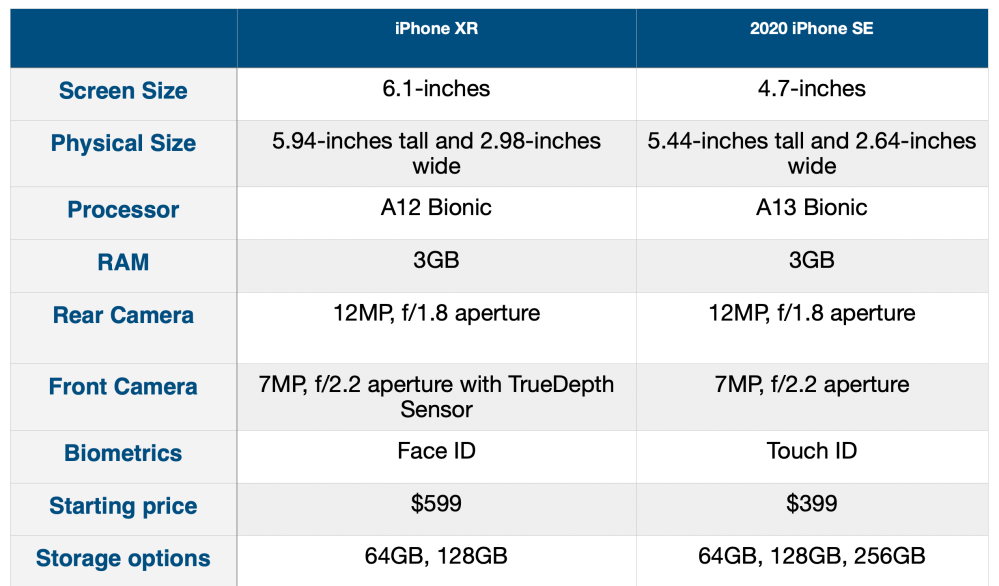
The low-end of Apple’s iPhone lineup is more robust than ever thanks to this week’s introduction of the iPhone SE and the continued availability of the iPhone XR. The two devices offer very different sets of features, but which should you buy in 2020? Read on for our full comparison.
iPhone SE vs iPhone XR: Design
On the surface, the iPhone SE and iPhone XR are very different. The iPhone SE largely resembles the iPhone 6 series of devices. You get a 4.7-inch display flanked by bezels on the top and bottom, with a Home button for navigation and Touch ID biometric authentication.
Meanwhile, the iPhone XR follows the modern iPhone design trends: much smaller bezels around the edges with a notch at the top with a 6.1-inch display. The notch houses the TrueDepth sensor for Face ID biometric authentication rather than Touch ID.
What about form factor? This is where the design differences really matter. The iPhone SE features a 4.7-inch display and measures in at 5.44-inches tall and 2.64-inches wide. Meanwhile, the iPhone XR features a 6.1-inch display and measures in at 5.94-inches tall and 2.98-inches wide.
What this means is that the iPhone XR will be slightly bigger in your hand, but you also get a significantly larger display. Is the lager form factor worth the larger display? That’s up to you to decide, and many people have firm opinions on their iPhone display size preferences.
Finally, both the iPhone XR and iPhone SE feature the same IP67 rating for water resistance. This means the devices can be submerged at a maximum depth of 1 meter for up to 30 minutes.
Best iPhone XR leather cases:
- Mujjo Full Leather Case for iPhone XR
- Nomad Folio Leather Case for iPhone XR
- ESR Real Leather Case for iPhone XR
- OtterBox Strada Series Case for iPhone XR
Best iPhone SE cases:
- Spigen Ultra Hybrid
- TORRAS Slim Fit
- Totallee Ultra Thin Frosted Clear
iPhone SE vs iPhone: Display
Speaking of displays, there are some other details to point out when comparing the iPhone SE and iPhone XR screens.
The iPhone XR features an LCD “Liquid Retina HD” display with a 1792×828 pixel resolution at 326 pixels-per-inch. Meanwhile, the iPhone SE features a “Retina HD” display with a 1334×750 pixel resolution, also at 326 pixels-per-inch. Both displays also feature a P3 wide color gamut and 625 nits of max brightness.
Other display features of both the iPhone XR and iPhone SE:
- LCD Multi-Touch display with IPS technology
- 1400:1 contrast ratio
- True Tone display
- Wide color display (P3)
- Haptic Touch
- Fingerprint-resistant oleophobic coating
Again, what all of this means is that the iPhone XR will be able to show much more information than the iPhone SE thanks to its larger display. Both displays, however, offer similar features and pixel density, so you can expect the same picture quality no matter which device you choose.
Power and battery life
Looking past the differences in designs and displays, there are also some under-the-hood differences between the iPhone XR and iPhone SE.
The iPhone SE is powered by Apple’s latest A13 Bionic processor. Yes, that’s the same processor Apple uses in the flagship iPhone 11 and iPhone 11 Pro. Meanwhile, the iPhone XR features the A12 Bionic processor, which is the same processor used in the iPhone XS and iPhone XS Max. Both devices are believed to have 3GB of RAM.
In real-world usage, you can expect similar performance between the iPhone XR and iPhone SE. Both devices should be relatively future-proof and perform more than enough power for day-to-day usage.
In terms of battery life, here are the (admittedly vague) battery statistics provided by Apple for the iPhone XR:
- Lasts up to 1.5 hours longer than iPhone 8 Plus
- Talk time (wireless): Up to 25 hours
- Internet use: Up to 15 hours
- Video playback (wireless): Up to 16 hours
- Audio playback (wireless): Up to 65 hours
And here are the (even vaguer) battery statistics for the iPhone SE:
- Lasts about the same as iPhone 8
- Video playback: Up to 13 hours
- Video playback (streamed): Up to 8 hours
- Audio playback: Up to 40 hours
Both devices are capable of fast charging and can add 50% in 30 minutes, but you’ll need to buy an 18W charger separately. Thankfully, you can easily upgrade to an 18W USB-C plug on Amazon for cheap. Both devices are also capable of wireless charging, but again, you’ll need to buy a Qi charger separately.
iPhone XR vs iPhone SE: Camera
The iPhone XR and iPhone SE both feature a single 12MP Wide camera on the back with a front-facing 7MP camera. The technical specifications between the two cameras are very similar:
- 12MP Wide camera
- ƒ/1.8 aperture
- Digital zoom up to 5x
- Portrait mode with advanced bokeh and Depth Control
- Optical image stabilization
- Six‑element lens
- LED True Tone flash with Slow Sync
- Panorama (up to 63MP)
- Autofocus with Focus Pixels
- Wide color capture for photos and Live Photos
- Advanced red-eye correction
- Auto image stabilization
- Burst mode
- Photo geotagging
- Image formats captured: HEIF and JPEG
The iPhone SE offers a few minor features that you won’t get with the iPhone XR:
- Portrait Lighting with six effects (Natural, Studio, Contour, Stage, Stage Mono, High-Key Mono)
- The iPhone XR features Portrait Lighting with three effects (Natural, Studio, Contour)
- Sapphire crystal lens cover
- Next-generation Smart HDR for photos
- iPhone XR features Smart HDR for photos, but not “next-generation”
Video recording features are also largely the same between the iPhone SE and iPhone XR:
- 4K video recording at 24 fps, 30 fps, or 60 fps
- 1080p HD video recording at 30 fps or 60 fps
- 720p HD video recording at 30 fps
- Extended dynamic range for video up to 30 fps
- Optical image stabilization for video
- Digital zoom up to 3x
- LED True Tone flash
- QuickTake video
- Slo‑mo video support for 1080p at 120 fps or 240 fps
- Time‑lapse video with stabilization
- Cinematic video stabilization (4K, 1080p, and 720p)
- Continuous autofocus video
- Take 8MP still photos while recording 4K video
- Playback zoom
- Video formats recorded: HEVC and H.264
- Stereo recording
The iPhone SE features two additional capabilities:
- Cinematic video stabilization (4K, 1080p, and 720p)
- iPhone XR only supports cinematic video stabilization at 1080p and 720p
- QuickTake video
Finally, the front-facing camera is notably different between the iPhone SE and iPhone XR in a few ways. This is due primarily to the fact that the iPhone XR features a TrueDepth sensor for Face ID, which is also used for features like Animoji and Memoji.
iPhone SE front-camera features:
- 7MP camera
- ƒ/2.2 aperture
- Portrait mode with advanced bokeh and Depth Control
- Portrait Lighting with six effects (Natural, Studio, Contour, Stage, Stage Mono, High-Key Mono)
- 1080p HD video recording at 30 fps
- Retina Flash
- QuickTake video
- Wide color capture for photos and Live Photos
- Auto HDR for photos
- Auto image stabilization
- Burst mode
- Cinematic video stabilization (1080p and 720p)
iPhone XR front-facing camera features:
- 7MP camera
- ƒ/2.2 aperture
- Portrait mode with advanced bokeh and Depth Control
- Portrait Lighting with six effects (Natural, Studio, Contour, Stage, Stage Mono, High-Key Mono)
- Animoji and Memoji
- 1080p HD video recording at 30 fps or 60 fps
- Smart HDR for photos
- Extended dynamic range for video at 30 fps
- Cinematic video stabilization (1080p and 720p)
- Wide color capture for photos and Live Photos
- Retina Flash
- Auto image stabilization
- Burst mode
Ultimately, the iPhone SE and iPhone XR should offer very similar camera performance. The iPhone SE offers a few newer features for the rear-facing camera, while the iPhone XR offers some additional front-facing capabilities thanks to the TrueDepth sensor.
Pricing
The iPhone SE and iPhone XR are the two most affordable iPhone models sold new by Apple. The iPhone SE starts at $399 for 64GB of storage. You can upgrade to 128GB for $449 and to 256GB for $549.
The iPhone XR starts at $599 for 64GB of storage, and you can step up to the 128GB model for $649. Apple does not offer the iPhone XR in any storage configuration larger than 128GB.
iPhone XR colors:
- White
- Black
- Blue
- Yellow
- Coral
- PRODUCT(RED)
iPhone SE colors:
- White
- Black
- PRODUCT(RED)
iPhone accessories you need
Other than cases, there are a few other things you might want to pick up for your new device, particularly if you’re upgrading from something like the original iPhone SE or iPhone 6.
- Native Union Drop 10W Qi Charger
- Apple’s 18W USB-C wall plug for fast charging
- USB-C to Lightning cable
- Lightning to 3.5mm headphone adapter or cable
Wrap up
The iPhone SE packs a powerful punch thanks to its A13 Bionic processor. The camera performance is also stellar thanks to the software support for features like Portrait mode and Portrait Lighting. In terms of design, the iPhone SE harkens back to the iPhone 6 — which was the most popular iPhone for a reason.
Meanwhile, the iPhone XR packs a slightly older A12 Bionic processor, but you get a larger 6.1-inch display and a modern “bezel-less” design. That being said, the larger display doesn’t appeal to everyone, and some might even find the iPhone SE too big.
The iPhone SE and iPhone XR appeal to two very different audiences.
For example, if you’re upgrading from an iPhone 6, iPhone 6s, iPhone 7, or iPhone 8, and you don’t want to learn the new gesture-based navigation system of the iPhone X and newer, then the iPhone SE is your best option. The Home button design and Touch ID authentication will feel familiar to many iPhone users.
But if you want a modern iPhone design, without splurging on the iPhone 11 or iPhone 11 Pro, the iPhone XR is your best option. Keep in mind, however, that the iPhone XR only offers up to 128GB of storage, so if you feel like you’ll hit that cap, you might consider the iPhone 11 instead.
And something else that’s important to remember is that both the iPhone XR and iPhone SE will be supported by Apple with regular software updates for the foreseeable future. You can buy either of these phones and use them for many years.
What do you think of Apple’s base iPhone options? Would you recommend the iPhone SE or iPhone XR? Let us know down in the comments!
Author: Chance Miller.
Source: 9TO5Mac









